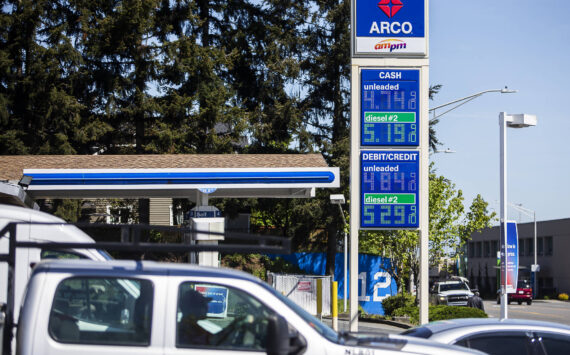Whether you work in a Tacoma business and want to get your message out on the web through video or are a teenager wanting to make a video with your friends, using the Internet to entertain and share through motion is the hot ticket.
Creating video for viewing on the Web is much more than a process of compression and output. It is also about creating original content for the unique environment of the Internet. The challenges facing the content creator are threefold, as I see it: presenting a unique production when repurposing is so easy, generating it frequently, and giving your show the polish to make it compelling without hiring your own in-house artisté.
An inexpensive video production with a quick turnaround can be mounted from any cubicle with one person in an anchor seat and without the involvement of the entire IT department. With a green screen and a camcorder, you can create any kind of broadcast quality video with you as the star. A Folsom, Calif. company called Serious Magic (www.SeriousMagic.com) has created a software tool with easy streaming media content creation in mind.
Ive been using Visual Communicator for years to send out video newsletters. I do it from the same workstation where Im writing this article and it takes longer to make my hair look good than it does to set up the green screen, a light, and the camera.
Ben Yoder of Serious Magic showed me how their Visual Communicator software allows anyone to quickly create professional video presentations in a few minutes right from our own desktop.
DANA GREENLEE: Give us an overview of what Visual Communicator can do.
BEN YODER: Visual Communicator is sort of a new category of application. It allows anyone to create professional video presentations in just minutes, even if they have never had any video experience whatsoever — something that looks like maybe it was professionally edited in the studio, but they can do it from their desktop and then e-mail[ed] to anyone in the world.
GREENLEE: Who are you seeing getting the most value out of this tool?
YODER: It’s across the board. We wanted to level the playing field and make it possible for a small business or individual working out of their home to create a professional video. We have a lot of small businesses that are now able to compete with the big businesses by creating videos for their Web sites and making them look like they spent thousands of dollars, but just doing it in-house. Were also seeing the big companies use it as well because it saves them so much time and money since they don’t have to have a multimedia team. If they want to do a human resources video or a press announcement, an individual person can just do it themselves without having to farm out the work. We’re also seeing a great deal of educational use. Lots of schools are buying Visual Communicator and integrating it into their classroom. Its also used a lot as a consumer application for everything from personal video messages to somebody making a video commercial for EBay.
GREENLEE: You must be seeing a trend that inspired you to come up with this type of software.
YODER: Our background was in high-end video production, creating technologies for use in TV stations. Weve always wanted to democratize the tools of television. Our primary reason is we think television and video are the most powerful forms of communication available. They cut through the noise. They hold the audience’s attention, gets them to focus, and cause action. We wanted to democratize those tools for everyone else so they could communicate with the same power. We didn’t set out to create a video-editing tool. It’s more of a communications tool.
GREENLEE: Does Serious Magic see themselves as streaming media facilitators?
YODER: Yes, we’re in the streaming media industry here. We’re seeing it grow and we see its potential. A big part of our mission is we want to address the content side because there are so many great companies working on the quality side of it. We wanted to make it possible, and see if it could be done, that the average person could create professional video in just minutes from their desktop. That was our goal.
GREENLEE: What file format does it output into?
YODER: Our software comes with a wizard that helps to build the show and then once you’re done recording your show, it has a wizard that walks you through how to share your show with people on the Internet or on CD. It breaks it down so it’s really simple for you to choose the bandwidth. Even in the media industry, the encoding side of it can still be pretty difficult. We try to make it as simple as possible without losing any of the benefits of selecting the options you want. We built in the Windows Media encoder, so the standard default if you choose to compress the video for an Internet audience, is going to save it as an .asf file. The reason for that is everybody has a Windows Media player so they don’t have to download anything special, even if you’re on a Macintosh. If you want to encode it in something different such as QuickTime or Real Player or any of these other codecs out there, you can save it as an uncompressed .avi file, which is a standard video format. From there you can take it into any encoder you already have and encode in any way you want. You can also download a free software update that allows you to use an encoder that’s already installed on your machine.
GREENLEE: Tell us about the interface?
YODER: We didn’t want to create another video editing package. Theres some great video editing tools out there but, in our opinion, the process is still very time-consuming and complicated for the average person. We wanted to give people a way to get the end results that look very professional but without doing those complicated editing steps. We started with the process. We actually created a teleprompter and build it right into Visual Communicator. You start by typing what you want to create in your video and you just simply drag-and-drop graphics next to the words they go with in the script. We’ve eliminated the tedious editing timeline so when people get to a specific part of the video where they want a picture or video clip to come up, they just put it right next to the words they go with. When they click Record, everything triggers instantly. The best analogy is a TV newsroom. At point of there top story, that’s when they’re video or graphics start playing and it’s all done in a sort of live timeline. Thats the way our program works — in real time. As soon as youre done talking, the video is done.
GREENLEE: Can a business use the software to make a professional television commercial? Is it of that caliber?
YODER: It is, in terms of the quality and the effects and the look of it. The first version is primarily meant for sharing over the Internet or Power Point or CDs. Our Pro version has full broadcast resolution output including print-to-tape and CD/DVD publishing. You can output it in 640 x 480.
GREENLEE: What type of computer and other hardware do you need to make this work well?
YODER: First and foremost, you need a video camera or a Web cam. You position the Web cam or camcorder on top or just behind your monitor. By doing so, when reading from that teleprompter, it directs your eyes in such a way so it looks like you’re looking right into the camera at a million-dollar TV station. As far as the PC hardware, we’re just looking for a Pentium III or faster computer. The Plus version of our software comes with a green screen which thumbtacks to the wall behind you. It also comes with a clip-on microphone. We’re taking care of the audio and the PC side is pretty standard.
GREEENLEE: If you don’t have a Web cam, you can create an audio version of a newsletter, correct?
YODER: Absolutely. Say you just got back from vacation and have your digital camera full of pictures. You can just drag-and-drop that into the interface and either record a slide show or write a script and actually narrate your slide show. Then you save that out as a movie you can e-mail to your friends and family.
GREENLEE: If you do want to go all-out, a digital camcorder is better bet than a Web cam, right?
YODER: Yes. Web cams have come a long way in recent years. A camcorder is typically better video quality than a Web cam, but either one can give you good results.






